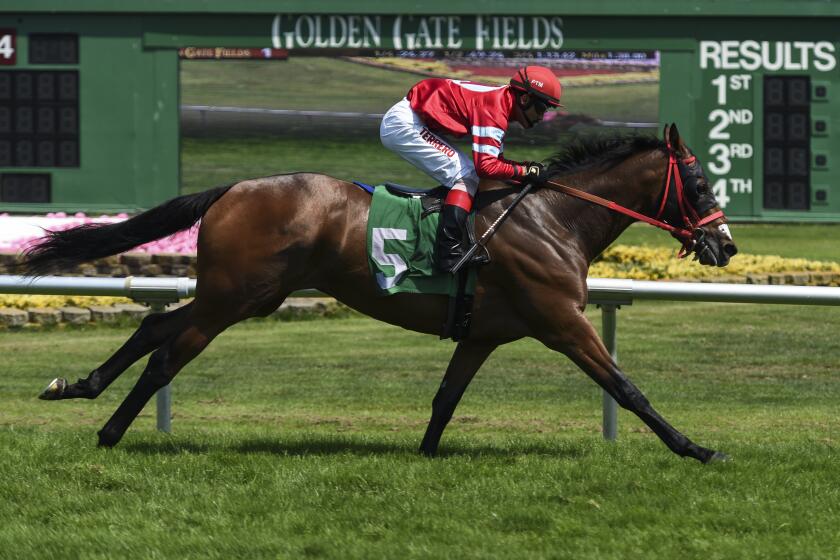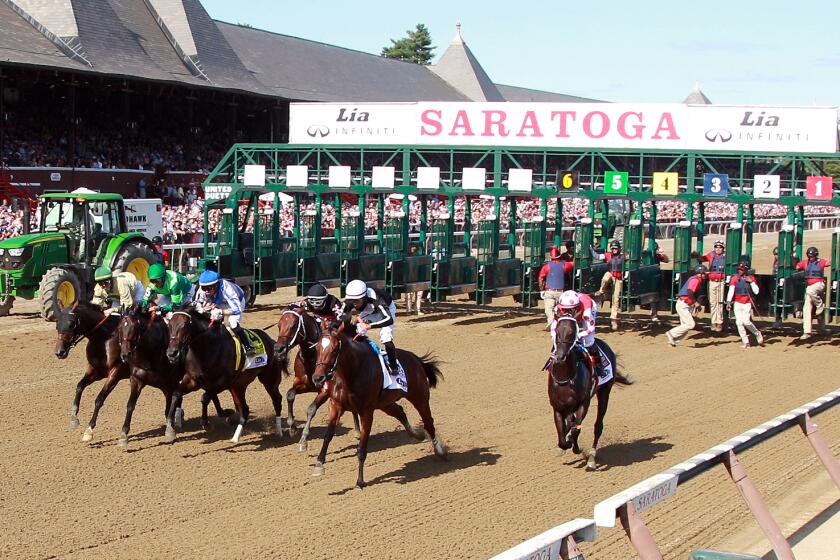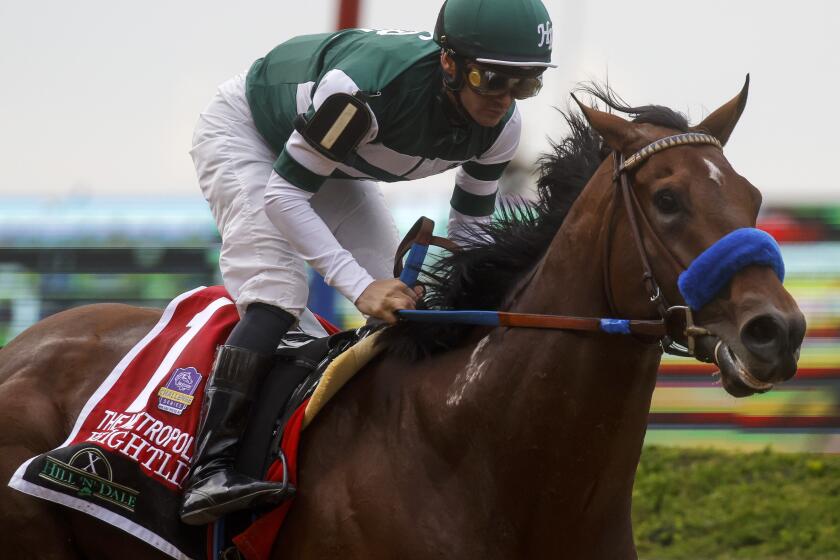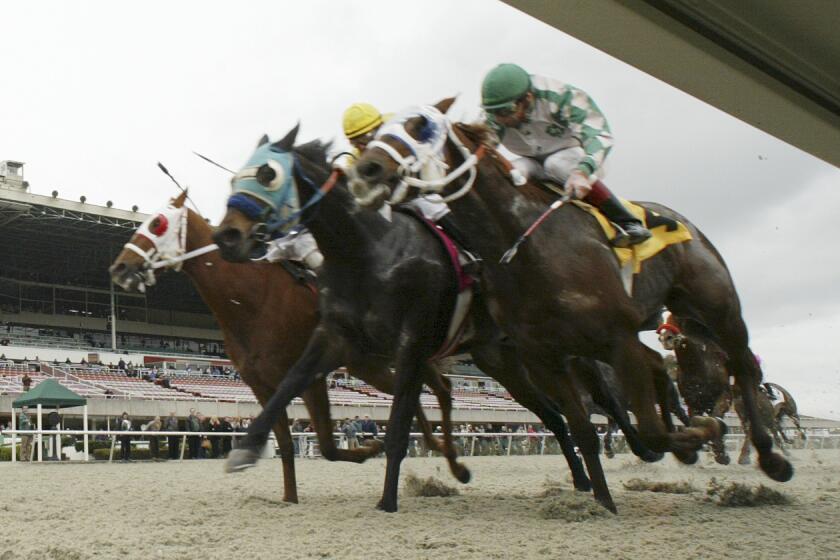Del Mar remains the bright spot on struggling California horse racing landscape
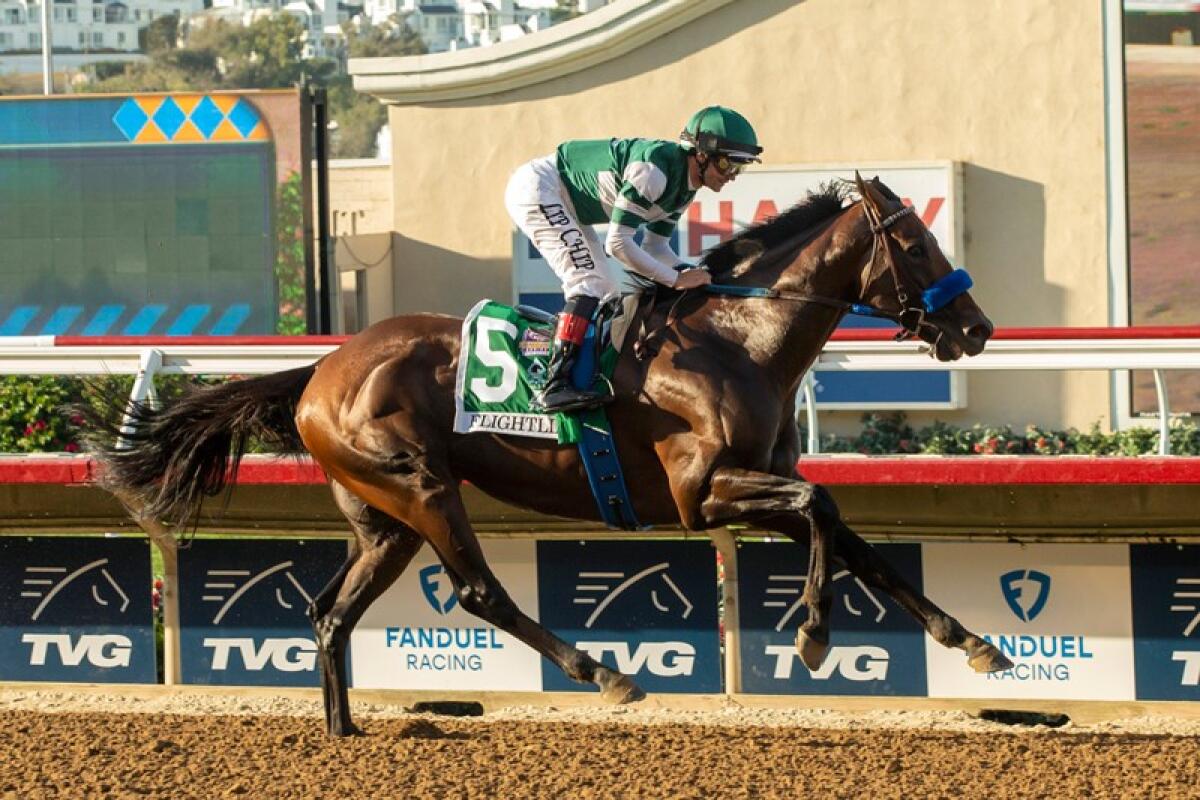
- Share via
As the summer comes to a close, and those who cling to the idea put all their white dresswear back in the closet, it becomes more apparent that stylish Del Mar has firmly established itself as the lone oasis in the arid California horse racing landscape.
The Stronach Group announced it is closing Golden Gate Fields, likely sometime in the middle of next year. The hope is that the horses will move south to Santa Anita to try to save the historic and picturesque track that needs to increase to four-days-a-week racing for any chance at long-term survival.
Los Alamitos, which runs a year-round quarter horse and low-quality thoroughbred meeting, still exists because of the conviction and commitment of 87-year-old owner Ed Allred. There is no one lined up to take his place.
And the California Fair circuit, which runs in the summer in Northern California, is hoping to fill the void left by Golden Gate but likely faces a future of just trying to hang on and not hemorrhage trainers and owners to other locations.
The Stronach Group has decided to permanently close down Golden Gate Fields in Berkeley after its final meet ends in December, boosting Santa Anita.
And then there is Del Mar.
“It doesn’t hurt that we are 100 yards from the Pacific Ocean and we race in the summer,” said Tom Robbins, a longtime fixture at Del Mar who is the executive vice president of racing and industry relations. “That’s a general attraction for people to come here. Plus the purses and financial incentives we offer during this period help drive our success.”
This year Del Mar set a California record for distributing more than $875,000 in purse money a day.
“And this is without any supplemental gaming revenues [such as slot machines], which is what all other major racing states have at their disposal,” said Josh Rubinstein, who has been chief operating officer since 2013. “When you put the money up that helps.
New York Thunder was far in front during the H. Allen Jerkens Memorial Stakes at Saratoga when he fell and subsequently was euthanized.
“Another thing is owners like to see their horses run in front of big crowds. We have a beautiful facility here that’s full pretty much every day. And great weather. When you combine that with strong purses and really quality racing, it’s a wave that we’ve been riding here.”
Del Mar has its biggest day of the meeting Saturday with the running of the $1-million Pacific Classic, the only million-dollar race in the state, outside of the Breeders’ Cup.
The winner will get a free pass to the $6-million Breeders’ Cup Classic, which will be held on Nov. 4 at Santa Anita. Geaux Rocket Ride is the 5-2 morning-line favorite in the Pacific Classic. The Richard Mandella-trained 3-year-old beat Kentucky Derby winner Mage in his last start while winning the Haskell Stakes in New Jersey.
Whatever happens Saturday, it’s highly unlikely to eclipse last year’s race, which saw Flightline win by 19¼ lengths. Some have called that the most dominating performance since Secretariat won the Belmont Stakes by 31 lengths in 1973.
But there will be no Flightline at this year’s Pacific Classic as racing, in its thirst for breeding money, tends to retire its stars, not race them. The undefeated colt ran only six lifetime races.
The Breeders’ Cup Classic could be Flightline’s last race. Even if he wins, some believe he hasn’t raced enough to be one of the all-time greats.
Last year’s Pacific Classic had six entrants; this year’s has 11 starters.
It’s the field size, or number of horses in each race, that has distinguished Del Mar as one of the most elite tracks in the country. Last year, Del Mar averaged 9.14 starters. This year, entering Thursday racing, the track is averaging 8.85 starters a race.
More runners is also a favorite of bettors, who are always chasing value in overlooked horses.
“Most bettors would rather have a 13-horse field, regardless of it’s a maiden special weight or claiming race [than a small-field stakes race],” said Johnny Avello, considered the dean of the Las Vegas’ sports betting industry. He is currently the director of race and sports book operations at DraftKings.
“A race with 13 horses, the payout is quite substantial. The four-horse stakes race, I just don’t understand that, especially a Grade 1 race for $500,000. Why doesn’t the race fill? It’s a watch and no wager race for me.”
When you talk about summer racing, the standard to which everything is measured is Saratoga in upstate New York.
“Saratoga has incredible racing and a tremendous history and a brand,” Robbins said. “We like to think we have a brand at Del Mar, but Saratoga has sensational racing and historical performances and Grade 1s and a tremendous stakes schedule throughout.
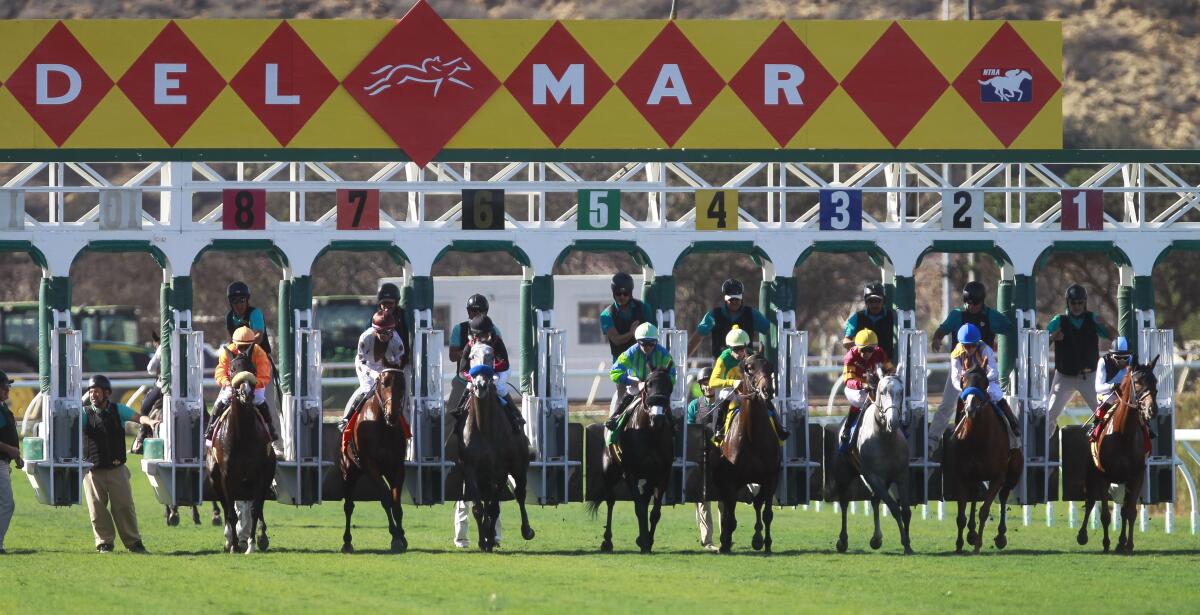
“I hate to say it, but they might be a little more established than we are. But we’ve jumped up considerably in the last couple of years. But they need good weather. They need luck. I think that is one area where I think we have an advantage.”
It certainly has proven this year. Saratoga has had an average field size of 7.56 entering racing Wednesday. But Saratoga has had bad weather this meeting as, entering this week, 59 races have been taken off the turf, resulting in fields that are scratched to just a few horses.
But, bettors still favor Saratoga when it comes to wagering. This year, the average bet per race at Saratoga is $1.95 million, compared to $1.42 million at Del Mar, according to data provided by Equibase, Horse Racing Nation and the New York Racing Assn.
“The boutique meets are special to bettors and they are special to me,” Avello said. “Del Mar, Saratoga, Keeneland and Kentucky Downs are meets that take place for [a short period]. … Saratoga has a country feel, while Del Mar has that Southern California beach vibe. It’s a great place to go. The weather is extraordinary.”
The Stronach Group remains quiet on plans surrounding the closure of Golden Gate Fields. Sen. Dianne Feinstein joins critics seeking answers to the closure.
Another factor is Saratoga being located on the East Coast and, well, Del Mar is not. Intuitively, its late East Coast start could be an impediment to race dollars. But that’s not the case.
“Interestingly, as soon as Saratoga is done, our out-of-state handle skyrockets,” Rubinstein said. “People on the East Coast are used to doing things later and especially now with ADW [advance deposit wagering usually done on phones and tablets] being so popular.
“We’ll be running the Pacific Classic like we have for several years, as the 10th race of 11. A few years ago, we asked the folks at [horse racing network] TVG about what’s the best slot for the Pacific Classic in terms of maximizing handle. Their response was as late as possible. When Saratoga is done, we are the dominant signal. … On the revenue side of it, the latter half of our card does much better than the front half and a big reason is because Saratoga is done with its day.”
Del Mar’s postcard-worthy role in California racing seems secure, for now, but if the state’s industry continues to contract and Del Mar is left on an island, it will face never-before-seen challenges. Its ability to adapt likely will be key to California racing’s existing at all.
More to Read
Go beyond the scoreboard
Get the latest on L.A.'s teams in the daily Sports Report newsletter.
You may occasionally receive promotional content from the Los Angeles Times.
